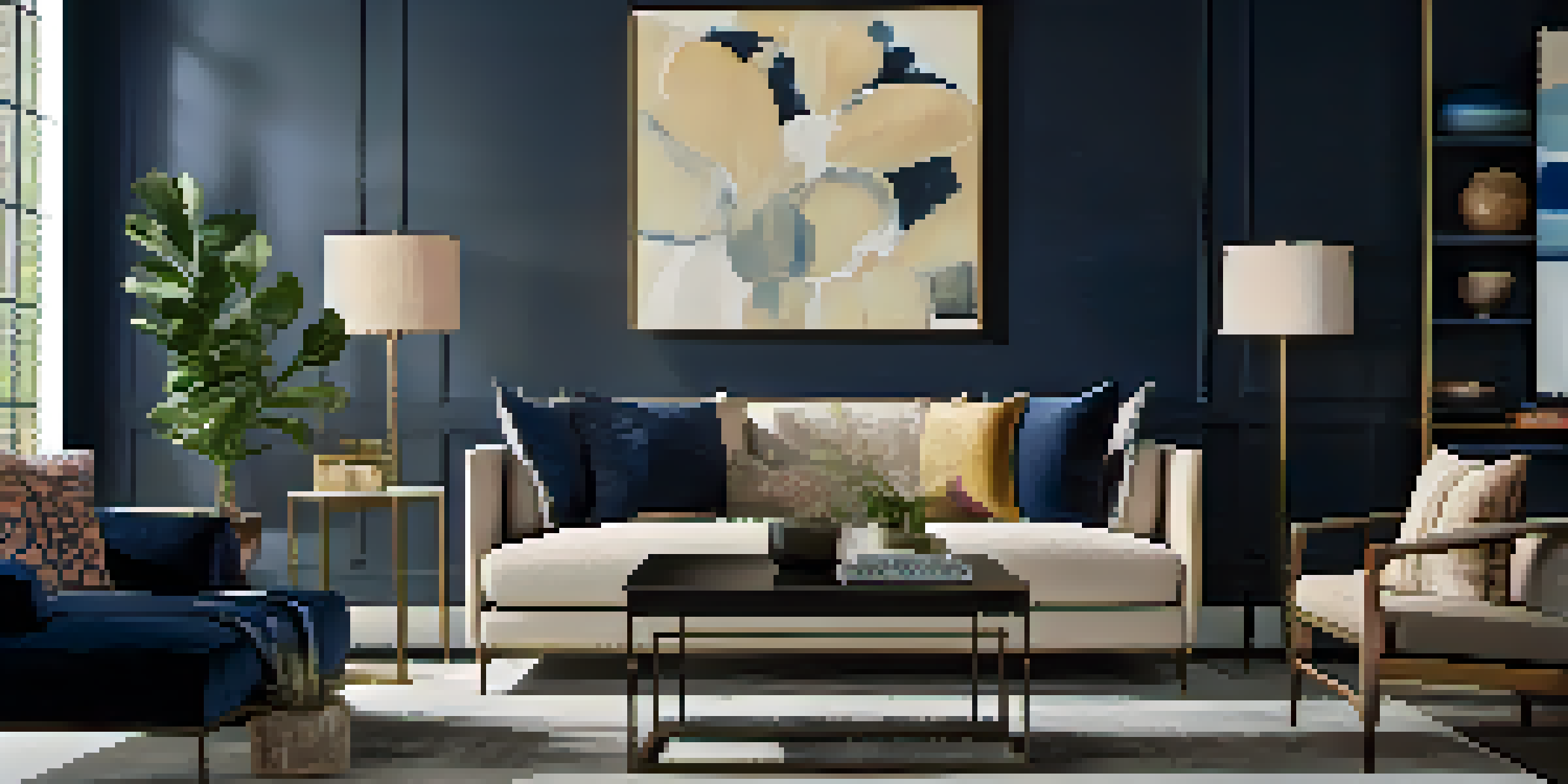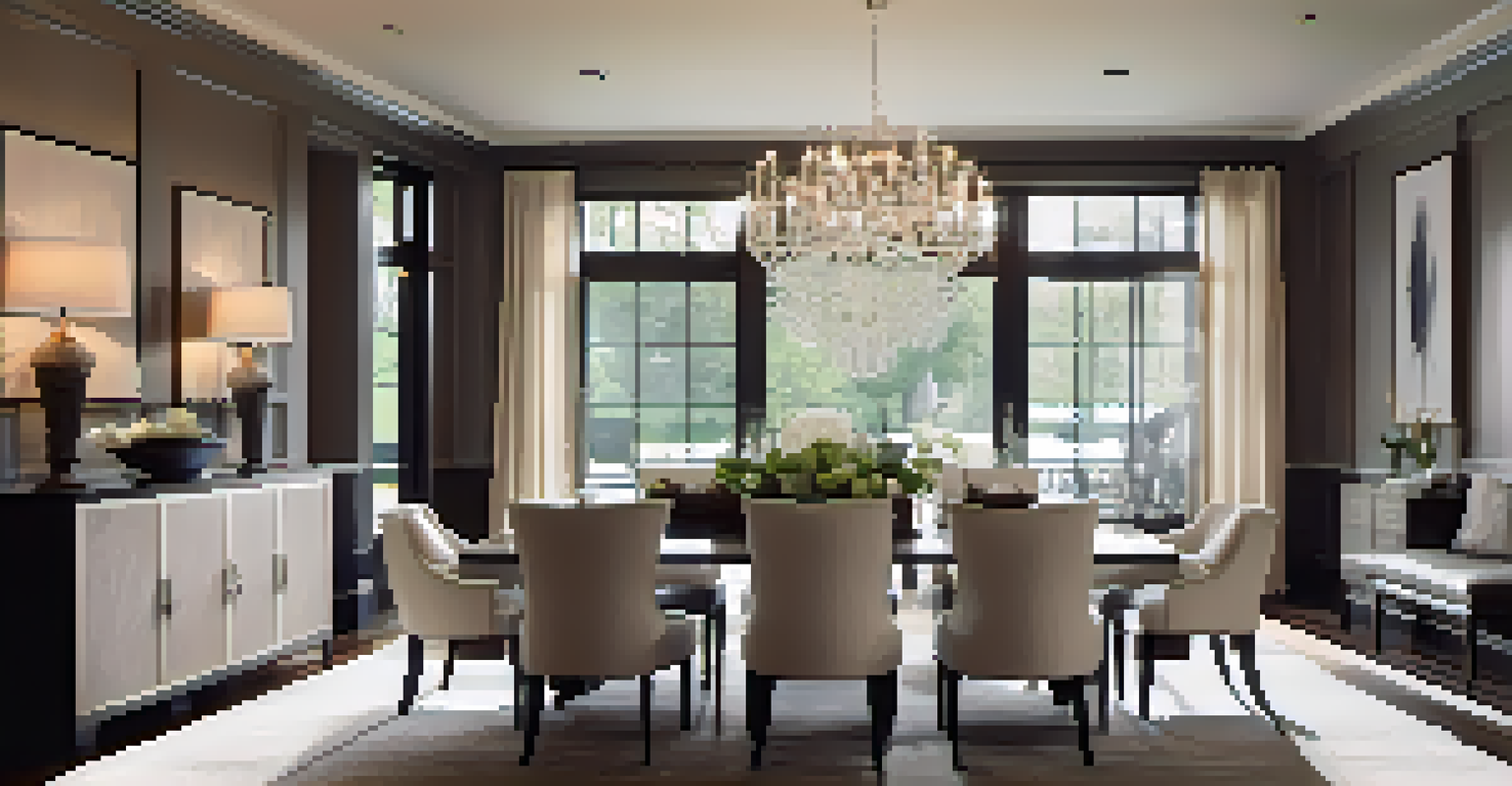Creating Contrast: Using Light and Dark Elements in Staging

Understanding the Basics of Light and Dark in Staging
When staging a space, the interplay of light and dark elements plays a crucial role. Light colors tend to open up a room, making it feel larger and more inviting, while darker shades can create intimacy and depth. By understanding how these elements work together, you can create a balanced atmosphere that appeals to potential buyers.
Color is the keyboard, the eyes are the harmonies, the soul is the piano with many strings.
Imagine walking into a room that is all white; it may feel sterile, lacking warmth. Conversely, a room painted entirely in dark tones could feel claustrophobic. The magic happens when you find the right blend, using light surfaces to highlight the darker accents and vice versa, transforming a space into something special.
Remember, the goal is to evoke emotion and create a narrative in the room. By thoughtfully balancing light and dark elements, you can guide the viewer’s eye and create focal points that enhance the overall ambiance of your staging.
Choosing the Right Color Palette for Contrast
The color palette you select is the foundation of your staging project. A harmonious mix of light and dark colors can add depth and interest to your space. For instance, pairing a soft beige with deep navy can create a striking contrast that feels both elegant and modern.

Consider using lighter colors for larger areas like walls and ceilings, while introducing darker shades in furniture or decor items. This not only creates a visually appealing contrast but also emphasizes key features of the room, such as architectural details or artwork.
Light and Dark Create Atmosphere
Balancing light and dark elements can evoke emotions and enhance the overall ambiance of a staged space.
Moreover, don't shy away from experimenting with various shades and tones. A well-thought-out color palette can evoke specific emotions, helping potential buyers envision their future in the space. It's all about finding that perfect balance.
Utilizing Natural Light to Enhance Contrast
Natural light is one of the best tools you have at your disposal when staging a home. It can dramatically change the perception of light and dark elements in your space. For example, a room flooded with sunlight can make lighter colors pop while softening the impact of darker shades.
Light is the symbol of truth, and darkness is the symbol of ignorance.
To maximize natural light, consider the placement of mirrors and reflective surfaces. These can help bounce light around the room, further enhancing contrast. A strategically placed mirror can create the illusion of a larger space while brightening darker corners.
Additionally, be mindful of window treatments. Opt for sheer curtains that allow light to filter through while still providing privacy. This way, you maintain that essential contrast between light and dark without sacrificing brightness or warmth.
Incorporating Textures for Depth and Interest
Textures play a significant role in staging, especially when dealing with light and dark elements. Mixing various textures can add depth to your design, enhancing the contrast between light and dark surfaces. Think about soft fabrics against hard surfaces or matte finishes paired with glossy accents.
For instance, a plush, light-colored sofa can create a stunning contrast against a dark wood floor, while a chunky knit throw can add warmth and invite touch. Textures not only provide visual interest but also appeal to the senses, making the space feel more inviting.
Natural Light Enhances Design
Utilizing natural light effectively can highlight colors and create a more inviting environment.
Moreover, layering different textures can help create a cohesive look. By thoughtfully combining materials like glass, wood, metal, and fabric, you can create a rich tapestry of contrast that draws the eye and keeps the viewer engaged.
Creating Focal Points with Light and Dark Elements
Focal points are essential in any staged space, and light and dark elements can help you achieve them effortlessly. A well-placed dark piece of furniture can serve as a striking centerpiece against a backdrop of lighter walls. This draws attention and creates a visual anchor in the room.
Consider using light colors to highlight architectural features, such as a fireplace or built-in shelves, while surrounding them with darker elements. This not only emphasizes the unique characteristics of the space but also creates a sense of balance.
Additionally, artwork can serve as a fantastic focal point. A bright, colorful piece can pop against dark walls, while a monochromatic print can add sophistication. By strategically selecting and positioning your focal points, you can enhance the overall staging of the space.
The Role of Lighting Fixtures in Contrast
Lighting fixtures are more than just practical; they can dramatically influence the contrast in a room. Pendant lights, sconces, and floor lamps can introduce both light and dark elements, creating layers of illumination. A well-chosen fixture can become a design statement while serving functional purposes.
For example, a sleek black chandelier can provide a bold contrast against lighter walls, becoming a conversation piece. Conversely, a soft white lamp can illuminate a dark corner, providing warmth and balance. Mixing different types of lighting can enhance the contrast even further.
Textures Add Depth and Interest
Incorporating various textures helps create visual interest and enhances the contrast between light and dark surfaces.
Remember to consider the placement and brightness of your fixtures. A well-lit space should have varying light levels, allowing for both bright and cozy atmospheres. By using lighting effectively, you can transform the mood of a room, emphasizing the contrast you've carefully crafted.
Final Thoughts on Balancing Light and Dark in Staging
Achieving the perfect balance of light and dark elements in staging is an art that requires thoughtfulness and creativity. It's about telling a story and evoking feelings that resonate with potential buyers. With the right approach, your staging can highlight the best features of a space while creating an inviting atmosphere.
As you experiment with different colors, textures, and lighting, always keep your target audience in mind. What appeals to them? How can you create a space where they can envision themselves living? The answers to these questions will guide your decisions.

In the end, effective staging is about making a lasting impression. By skillfully combining light and dark elements, you can create a space that feels both cohesive and captivating, one that draws people in and makes them want to stay.